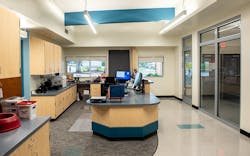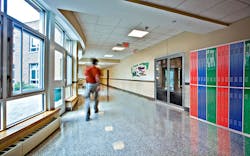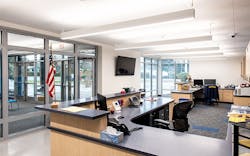Safety AND Security: The Importance of Component Compatibility
Last month, the Missouri House of Representatives passed a bill requiring all first-floor entryways and exterior windows in school settings to be bullet-resistant. Earlier this year, the Texas Education Agency (TEA) began requiring all ground-level exterior doors and windows to be reinforced with forced-entry resistant film. In Ohio, there is a bill in development that would require all glass in exterior doors to be bullet-resistant.
These are just a few examples of how states are taking steps to increase the safety and security of their schools. As the next code development cycle for the International Building Code (IBC) draws closer, a growing number of stakeholders are wondering if similar requirements for safer school design will be included in the IBC. Within this discussion, there is an important but often overlooked concern: as school administrators, legislators and the building industry work together to improve school security, it is crucial to also stay focused on fire and life safety. This is particularly vital in areas that may need to provide multiple forms of protection.
But creating systems that guard against different life safety threats is not as simple as pairing security and fire-rated components. Many ballistic- or forced-entry rated products are plastic-based and so can burn quickly and intensely. Combining them with fire-rated materials to meet applicable building codes and security goals can prove problematic, potentially compromising a fire-rated component’s ability to perform as specified.
What many do not realize is that current testing standards do not require systems to undergo multiple testing protocols—fire-rated components are subjected to the fire test, and security-rated components are tested to the standards specific to their ratings. For systems that may need to provide multiple forms of protection, such as those along paths of egress, close building return conditions and in certain corridors, the combination of components can unintentionally cause a system to provide less protection than desired (or required).
To ensure the selected products will meet all expectations and provide optimal safety and security for students and teachers, it’s important for codes to acknowledge the interplay between these forms of protection. But what would these acknowledgments look like and how might they affect school design and construction?
How can model code changes help ensure safer school design?
As districts elect to follow best-practice guidelines and states legislate more stringent security standards, making provisions for systems in areas where multiple life safety threats overlap, at the very least, could make designing safer schools more efficient for architects and specifiers. It could also reduce the potential of unintentionally putting occupants at risk or in a situation where they must choose between evacuation and lockdown procedures.
If code changes also address component compatibility, then they may help reduce potential design complications. Currently, if a firm is planning a glazing assembly that is intended to provide bullet-resistance, forced-entry resistance or any other security rating alongside code-driven fire rating requirements, its team may need to cross-reference product listings and materials to achieve the level of protection indicated in the component details. Glazing systems in which all components have been jointly tested would ease research requirements for specifiers while also ensuring an assembly would perform as intended on all levels.
Beyond improved specification, component compatibility can help keep occupants safer during emergencies—especially in situations that may be ambiguous as to whether occupants should follow evacuation or lockdown procedures. Glazing assemblies that can protect against multiple life safety threats allow occupants more time to assess their best course of action, which could be waiting for first responders to arrive.
What this could mean for school and building design in general
Multifunctional, fire-rated glazing assemblies made from compatible products or tested together across multiple standards can help improve safety and security in schools. But that’s not all they can do. Being able to replace traditional opaque materials with transparent glazing can help support daylighting goals as well as create open sightlines between spaces—a design feature that works with other best-practice security recommendations. Increased visual connection may also help mitigate instances of bullying as it reduces areas where victims can be isolated, a desire cited by students and architects alike.
While daylighting and visibility benefits are particularly important to student learning, they can be generalized to other buildings as well. Interior spaces that feel open, provide access to natural light and establish a visual connection between areas can improve the occupant experience of a built environment. Further, general-use buildings are not immune to targeted gun-violence, so development of codes that address security threats in tandem with fire safety may help improve occupant safety beyond the classroom.
About the Author

Devin Bowman, TGP
Devin Bowman is General Manager of Technical Glass Products (TGP) and AD Systems. With over 20 years of industry experience, Bowman is actively involved in advancing fire- and life-safety codes and sits on the Glazing Industry Code Committee (GICC).
Email: [email protected]
Contact him at: (800) 426-0279


